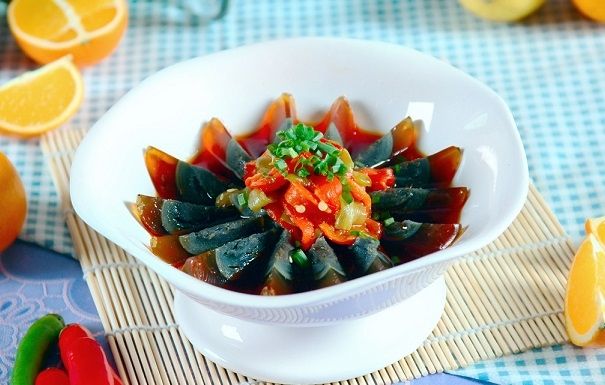皮蛋

Century egg or pidan , also known as preserved egg, hundred-year egg, thousand-year egg, thousand-year-old egg, and millennium egg, is a Chinese cuisine ingredient made by preserving duck, chicken or quail eggs in a mixture of clay, ash,salt,quicklime, and rice hulls for several weeks to several months, depending on the method of processing.
Through the process, the york becomes a dark green to grey colour, with a creamy consistency and anodor of sulphur and ammonia, while the white becomes a dark brown, translucent jelly with salty or little flavour. The transforming agent in the century egg is its alkaline material, which gradually raises the PH of the egg to around 9–12, or more during the curing process. This chemical process breaks down some of the complex, flavorless proteins and fats, which produces a variety of smaller flavorful compounds.
Some eggs have patterns near the surface of the egg white that are likened to pine branches, and that gives rise to one of its Chinese names, the pine-patterned egg.

Uses
Century eggs can be eaten without further preparation, on their own or as a side dish. The Cantonese wrap chunks of this egg with slices of pickled qinger root (sometimes sold on a stick as street food ). A Shanghainese recipe mixes chopped century eggs with chilled tofu. In Taiwan, it is popular to eat century eggs by slicing them, and placed on top of cold tofu with katsuobushi, soy sauce, and sesame oil in a style similar to Japanese hiyayakko. A variation of this recipe common in northern China is to slice century eggs over chilled silken (soft) tofu, adding liberal quantities of shredded young ginger and chopped spring onions as a topping, and then drizzling light soy sauce and sesame oil over the dish, to taste.